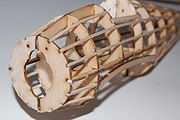Ochroma pyramidale
| Ochroma pyramidale | |
|---|---|
 | |
| Ochroma pyramidale at the Large tree habit at Tropical Gardens of Maui, Iao Valley Road, Maui | |
| Scientific classification | |
| Kingdom: | Plantae |
| (unranked): | Angiosperms |
| (unranked): | Eudicots |
| (unranked): | Rosids |
| Order: | Malvales |
| Family: | Malvaceae |
| Subfamily: | Bombacoideae |
| Genus: | Ochroma Sw. |
| Species: | O. pyramidale |
| Binomial name | |
| Ochroma pyramidale (Cav. ex Lam.) Urb. | |
| Synonyms | |
|
Bombax pyramidale Cav. ex Lam. | |
Ochroma pyramidale, commonly known as the balsa tree, is a species of flowering plant in the mallow family, Malvaceae. It is a large, fast-growing tree that can grow up to 30 m (98 ft) tall. Balsa wood is a very lightweight material with many uses. Balsa trees are native to southern Brazil and Bolivia north to southern Mexico.
Biology
A member of the mallow family, O. pyramidale is native to southern Mexico to southern Brazil, but is now found in many other countries (Papua New Guinea, Indonesia, Thailand, Solomon Islands). It is a pioneer plant, which establishes itself in clearings in forests, either man-made or where trees have fallen, or in abandoned agricultural fields. It grows extremely rapidly, up to 90 ft (27 m) in 10–15 years. The speed of growth accounts for the lightness of the wood, which has a lower density than cork. Trees generally do not live beyond 30 to 40 years.[2]
Flowers are produced from the third year onwards, typically at the end of the rainy season when few other trees are in flower. The large flowers open in the late afternoon and remain open overnight. Each may contain a pool of nectar up to 1 in (2.5 cm) deep. Daytime pollinators include capuchin monkeys. However most pollination occurs at night. It was once thought that the main pollinators were bats; however recent evidence suggests that two nocturnal arboreal mammals, the kinkajou and the olingo, may be the primary pollinators.[2]
Cultivation
Ecuador supplies 95 percent or more of commercial balsa. In recent years, about 60 percent of the balsa has been plantation grown in densely packed patches of around 1000 trees per hectare (compared to about two to three per hectare in nature). It is evergreen or dry-season deciduous, with large (30–50 cm or 11.8–19.7 in) weakly palmately lobed leaves. Being a deciduous angiosperm, balsa is classified as a hardwood despite the wood itself being very soft. It is the softest commercial hardwood. The trees are harvested after six to 10 years of growth. The name balsa comes from the Spanish word for "raft".[3]
Uses
Balsa lumber is very soft and light, with a coarse, open grain. The density of dry balsa wood ranges from 40–340 kg/m3 (2.5–21.2 lb/cu ft), with a typical density of about 160 kg/m3 (10 lb/cu ft).[4] The wood has a low density because it has large cells that contain water, which are evaporated in a kiln over two weeks. The large surface area of the resulting holes gives strength. Unlike dry, rotted wood, the surface is made of the usual strong cellulose/lignin mix.[5] Because it is low-density but high in strength, balsa is a very popular material to use when making light, stiff structures in model bridge tests, model buildings, and for the construction of model aircraft — especially free flight model aircraft, as well as full-sized light wooden aeroplanes, most notably the World War II de Havilland Mosquito.[5] Balsa is used to make wooden crankbaits for fishing. Sticks of balsa can be used to make crude dip-pens for calligraphy and can be useful when one needs a specific nib-width or structure absent immediately available metal nibs.
Balsa wood is often used as a core material in composites; for example, the blades of many wind turbines are made partially of balsa. In table tennis bats, a balsa layer is typically sandwiched between two pieces of thin plywood. Balsa wood is also used in laminates with glass-reinforced plastic (fiberglass) for making high-quality balsa surfboards and the decks and topsides of many types of boats, especially pleasure craft under 30 m (98 ft) in length. Starting with the 5th generation Chevrolet Corvette, the floor pan of the Corvette was composed of balsa sandwiched between two sheets of carbon fiber reinforced plastic.[5] Norwegian scientist/adventurer Thor Heyerdahl, convinced that early contact between the peoples of South America and Polynesia was possible, built the raft Kon Tiki from balsa logs, and upon it he and his crew sailed the Pacific Ocean from Peru to the Polynesian Tuamotu Archipelago in 1947. Balsa wood is also a popular wood type used in the art of whittling.[5]
Gallery
-

Balsa on Bota Hill, Limbe Botanical Garden, Cameroon
-

Painting by Frances W. Horne from the Flora Borinqueña
-

Ochroma pyramidale at the Large tree habit at Tropical Gardens of Maui Iao Valley Rd, Maui
-

Two balsa rafts and a kayak at Lagos de Montebello in Chiapas, Mexico.
-

Three different sizes of balsa wood stock.
-

Balsa construction in a Paul K. Guillow, Inc. "stick & tissue" free flight rubber scale model airplane.
See also
References
- ↑ "Ochroma pyramidale (Cav. ex Lam.) Urb.". Germplasm Resources Information Network. United States Department of Agriculture. 2009-10-26. Retrieved 1997-05-22. Check date values in:
|accessdate=(help) - ↑ 2.0 2.1 Angier, N. & Ziegler, C. (2011). "Treetop happy hour". National Geographic 219 (5): 130–143{{inconsistent citations}}
- ↑ "balsa, n.". OED Online. March 2013. Oxford University Press. 9 May 2013 <http://www.oed.com/view/Entry/15041?redirectedFrom=Balsa&>.
- ↑ Terry Porter: "Wood Identification and Use", page 160. Guild of Master Craftsman Publications Ltd. 2004
- ↑ 5.0 5.1 5.2 5.3 "Balsa Wood description". Retrieved 2011-01-02.
External links
-
 Data related to Ochroma pyramidale at Wikispecies
Data related to Ochroma pyramidale at Wikispecies -
 Media related to Ochroma pyramidale at Wikimedia Commons
Media related to Ochroma pyramidale at Wikimedia Commons